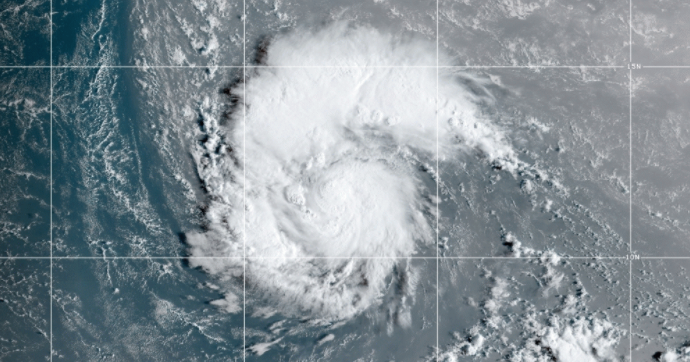
Hurricane Sam strengthened into a Category 2 storm late on Friday and was expected to become a major hurricane as it moved west across the Atlantic Ocean, forecasters said. It was not expected to threaten land.
The hurricane was about 1,200 miles east-southeast of the Northern Leeward Islands as of 11 p.m. Eastern time, moving at 14 miles per hour, with maximum sustained winds of 100 m.p.h., according to the National Hurricane Center.
Sam, which formed on Thursday in the central Atlantic, is the fourth named storm to develop in less than a week and the 18th overall in a busy 2021 Atlantic hurricane season.
“It is too early to tell what, if any, impacts could occur in the United States or any other land areas,’’ Dennis Feltgen, a meteorologist at the hurricane center in Miami, said on Friday.
Although the system paused in strengthening around midday on Friday, Mr. Feltgen said that Sam would likely develop into a “major” hurricane on Saturday. The Saffir-Simpson scale classifies major hurricanes as Category 3 or higher, with maximum sustained winds above 110 m.p.h.
“All folks need to do right now is check the latest forecast as we get into next week,’’ Mr. Feltgen. He said people should ensure they have a hurricane plan, including supplies, in place.
“With more than two months to go in the hurricane season, it is certainly possible that the 2021 Atlantic list of names will be exhausted,’’ Mr. Feltgen said.
Also on Friday, Subtropical Storm Teresa formed north of Bermuda, becoming the 19th named storm of the hurricane season. Teresa has a small window to “intensify slightly” but it is likely to dissipate in a day or two and also is not expected to threaten land, forecasters said.
After Sam and Teresa, the next named storms would be Victor and Wanda.
If forecasters go through the list, they will turn to an additional set of names approved by the World Meteorological Organization this year. That list begins with Adria, followed by Braylen and Caridad.
Last year, there were 30 named storms, including six major hurricanes, forcing meteorologists to exhaust the alphabet for the second time and move to using Greek letters. It was the most named storms on record, surpassing the 28 from 2005, and the second-highest number of hurricanes.
This year, the arrival of peak hurricane season — August through November — has led to a run of named storms that formed in quick succession, bringing stormy weather, flooding and damaging winds to parts of the United States and the Caribbean.
Tropical Storm Odette formed on Sept. 17, followed days later by Peter and Rose. All three storms have since dissipated.
Tropical Storm Mindy hit the Florida Panhandle on Sept. 8, just hours after it formed in the Gulf of Mexico, and as a powerful Hurricane Larry was simultaneously churning in the Atlantic.
Ida battered Louisiana as a Category 4 hurricane on Aug. 29 before its remnants brought deadly flooding to the New York area.
The links between hurricanes and climate change are becoming more apparent. A warming planet can expect stronger hurricanes over time, and a higher incidence of the most powerful storms — though the overall number of storms could drop, because factors like stronger wind shear could keep weaker storms from forming.
Hurricanes are also becoming wetter because of more water vapor in the warmer atmosphere; scientists have suggested storms like Hurricane Harvey in 2017 produced far more rain than they would have without the human effects on climate. Also, rising sea levels are contributing to higher storm surge — the most destructive element of tropical cyclones.
Ana became the first named storm of the 2021 season on May 23, making this the seventh year in a row that a named storm developed in the Atlantic before the official start of the season on June 1.
In May, scientists with the National Oceanic and Atmospheric Administration forecast that there would be 13 to 20 named storms this year, six to 10 of which would be hurricanes, including three to five major hurricanes of Category 3 or higher in the Atlantic.
NOAA updated its forecast in early August, predicting 15 to 21 named storms, including seven to 10 hurricanes, by the end of the season on Nov. 30. Sam is the 18th named storm to form this year.
Johnny Diaz Vimal Patel and Daniel Victor contributed reporting.



